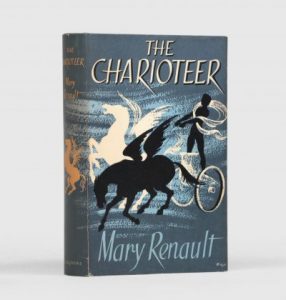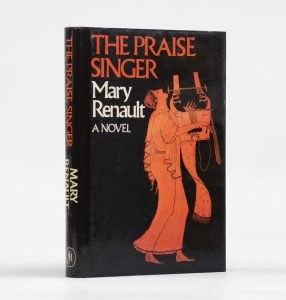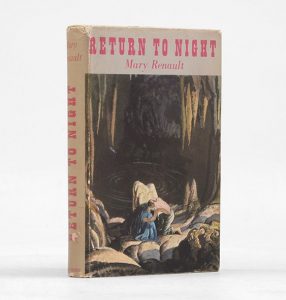For a novelist often regarded as ‘middle-brow’, twentieth-century author Mary Renault’s books are striking in their historical accuracy, psychological complexity and meaningful social impact. Scholars agree that her historical fiction is remarkably faithful: ‘The only bonafide Hellenist in twentieth-century fiction,’ Professor Bernard F. Dick wrote of Renault in 1972; ‘a real grip and feeling for the realities of the ancient world,’ observed Oxford University Fellow Robin Lane Fox in a 2013 interview for the BBC. Indeed, Renault’s historical novels, which are set against the backdrop of Greece and its former empire, can offer gripping reading material for budding classicists: in a tribute to Renault in The New Yorker, American writer Daniel Mendelsohn, a life-long fan of her work, quotes an Oxford don who once ‘told an eager amateur that to get a sense of what ancient Greece was really like one had only to read Renault—“Renault every time.”’ Although she studied English at Oxford University, Renault had no formal education in Classics and only visited Greece twice herself. Her high level of repute among academics is thus impressive.
Through the lens of her work it appears that Renault, who lived between 1905 and 1983, viewed the classical world as the cultural golden age. Had she joined the ‘ancients versus moderns quarrel’ of the 1700s, which saw academics debate the superiority of ancient literature over modern, and vice versa, Renault would almost certainly have advocated for the former. Particularly revealing was her definitive switch in 1956 from writing contemporary works set in Britain to solely publishing novels that fictionalise the ancient world. She had found a new formula: her Mediterranean backdrops are deeply transportive; her admiration for cerebral, pioneering Greeks, such as Alexander the Great, Socrates and Plato, brings them to life.

Mary Renault
Renault’s work has both united and divided readers over the years: powerful touchstones for many gay readers in their positive depiction of homosexual love, her books also contain some problematic attitudes. These more unappealing aspects of her work can often be grounded within the context of Renault’s veneration of the mores and values of the ancient world. In a BBC documentary to mark 60 years since the publication of Renault’s groundbreaking book The Charioteer (1953), radio broadcaster Sue MacGregor pertinently observed that ‘Mary had quite rigid ideas about noble societies, and she felt we’d lost this in the 20th century world’. Her Greek heroes, most often young men of aristocratic birth, are idealised for their embodiment of adventure, morality and honour, and her novels place a high value on individual triumph and acts of valour. In The Last of the Wine (1956), the novelist’s first Hellenic tale, the qualities which elevate her characters are captured in a letter from a father to his adolescent son, whom he advises to search for valiance and rectitude in future lovers. At times, Renault seems to fixate on championing attributes like these in her characters, overlooking the structural inequalities in the ancient societies of her novels which set limits on who was able to evince these prized qualities.
The Charioteer, which despite its classical-sounding title paints a moving portrait of a young corporal’s sexual bildungsroman in post-war Britain, secured Renualt’s place in the gay literary canon for its postive and nuanced depiction of homosexual love, rare in literature at the time. It also, unsurprisingly, caused controversy – particularly in the United States, where it remained unpublished for six years. In her ancient Greek novels, however, Renault was able to accurately situate romantic and physical relationships between men as social convention, and writing about this period allowed her to portray these relationships with significantly less backlash. In ancient Greece intimacy between men (notably of the pederastic form) was not viewed as other; there is, in fact, no equivalent ancient Greek word for ‘homosexual’, only distinct terms to denote roles (such as erastes – the mature male, and eromenos – his adolescent lover). Ironically, The Last of the Wine, which Renault wrote following The Charioteer and which also deals with a romance between men as its central theme – this time, in ancient Athens – saw great success in America.

RENAULT, Mary. The Charioteer. 1953. £375.00. (Item sold)
According to Renault the presentation of ‘acceptable’ homosexuality, made possible by her novels’ new context, was inspired by the belief of one of her own characters in The Charioteer: ‘it’s not what one is; it’s what one does with it.’ In the ancient world Renault imagined a place where her characters were not restricted by their sexual identity. This may reflect a desire to avoid in her narratives what she, harshly, deemed self-pity; in a letter to Mendelsohn, with whom she maintained a decades-long correspondence – she described Radcylffe Hall’s notorious lesbian novel The Well of Loneliness as containing an “impermissible allowance of self-pity”. Renault and her lifelong romantic partner, Julie Mullard, lived together for fifty years, until Renault’s death, but neither identified as ‘lesbian’, disliking the term for themselves.
Renault seems to have wrestled with her own identity, and remarked on more than one occasion that she wished she had been born male, and felt better suited to what was considered boyish behaviour when she was a child. Her mother was hostile about this, and apparently made clear her preference for Renault’s more feminine sister. These biographical aspects may help to illuminate why Renault chose to write predominantly about male love and adventure, while a disheartening majority of her female characters fulfil marginal, stereotypical roles. Renault did not identify as what she saw as typically female, and made problematic comments in letters to friends about women whom she judged lightweight and domesticised (traits her traditionally-minded mother would probably have approved of), while David Sweetman’s 1993 biography of Renault quotes a letter in which she describes spending time with housewives: “I have a terribly sad feeling like looking at a lot of animals that have moulted and got silly from being kept in a cage”. Convention considerably restricted women in Renault’s lifetime, and her inability to live openly with a female partner would have represented another check to her freedom. This is likely the reason she and Mallard chose in 1948 to emigrate to Durban, South Africa, where they were able to live more freely in the comparatively liberal atmosphere of an artistic ex-pat community. We may speculate, however, that Renault’s choice of homosexual love between bold heroes, in command of their own fate, as a subject for her novels was driven by these factors: the freedom she sought may, justifiably, only have been imaginable as male.

RENAULT, Mary. The Last of the Wine. 1956. £800.00. (Item Sold)
That The Charioteer and her subsequent Hellenic novels dealt straightforwardly with homosexual attraction served as a source of solace and affirmation for millions of gay readers, who would likely have been prosecuted or persecuted had they been ‘discovered’ in the 1950s, and in decades afterwards. Daniel Mendelsohn’s retelling of the impact Renault’s work had on his formative years illustrates the beacon of hope she offered even in the 1970s:
Reading Renault’s books, I felt a shock of recognition. […] Until that moment, I had never seen my secret feelings reflected anywhere. Pop music meant nothing to me, since all the songs were about boys wanting girls or girls wanting boys; neither did the Y.A. novels I’d read, for the same reason. Television was a desert. (“Will & Grace” was twenty-five years in the future.) Now, in a novel about people from another place and time, it was as if I had found a picture of myself.
It is hard to overestimate the impact such a moment must have had on a young person’s sense of self, and it led Mendelsohn to secrete his feelings in a letter to Renault in South Africa. Though her initial response was characteristically unsentimental, the exchange marked the beginning of the long correspondence between them.

RENAULT, Mary. The Praise Singer. 1978. £50.00. (Item sold)

RENAULT, Mary. Return to Night. 1947. £65.00.
Renault’s books also gained new meaning for some during the AIDS crisis of the 1980s. In a Guardian article entitled ‘Mary Renault’s The Charioteer is antidote to shame’, English Actor Simon Russell-Beale touchingly describes the comfort he found in her work:
At a simple, visceral level the picture of handsome men falling in love without guilt or shame was the perfect antidote to life in a city traumatised by the arrival of a hideous disease.
In Renault’s novels readers may find as many questions as they do answers, but this only adds to their depth and interest. For an aspiring classicist, her historical fiction can add colour to ancient Greek culture and society; for feminists, her novels may raise challenging issues; for LGBTQ+ readers, they have confirmed, excited and reassured. What is certain is Renault’s ability to capture the imagination; to draw you into an ancient world.





